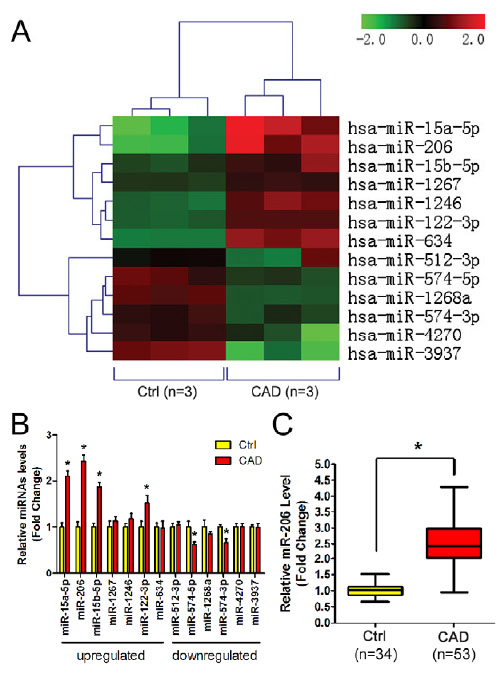Coronary artery disease is a major cause of morbidity and mortality worldwide. Impaired endothelial function and integrity are major contributory factors to coronary artery disease. Because microRNAs have been proposed to play an important role in coronary artery disease pathogenesis, a recent study pubished by researchers from the Shanghai Jiaotong University School of Medicine sought to find if the expression of miR-206 was found to be significantly upregulated in peripheral blood endothelial progenitor cells from patients with coronary artery disease compared with healthy donors. Through their work, miR-206 was found to regulate endothelial progenitor cell activities by targeting the protein kinase PIK3C2α, which showed decreased expression in coronary artery disease endothelial progenitor cells, as indicated through LC Sciences’ miRNA microarray service.
Knockdown of miR-206 in coronary artery disease endothelial progenitor cells rescued their angiogenic and vasculogenic abilities both in vitro and in vivo in a mouse ischemic hindlimb model. Furthermore, knockdown of miR-206 activated not only PIK3C2α but also the angiogenic signal modulators Akt and eNOS. Researchers propose that repression of the PI3K/Akt/eNOS signal transduction pathway by miR-206 downregulates angiogenesis contributing to the pathophysiology of coronary artery disease.
Analysis of the miRNA expression levels in patients with CAD and healthy controls.

(A) Heat map showing the unsupervised hierarchical clustering of 13 differentially expressed miRNAs in peripheral blood EPCs from three patients with CAD and three healthy donors (Ctrl). (B) The relative expression levels of the 13 miRNAs were validated by qRT-PCR and were normalized to RNU6B. (C) The miR-206 expression levels in peripheral blood EPCs from healthy donors (Ctrl) and patients with CAD were analyzed by qRT-PCR. Expression levels were normalized to RNU6B. *P < 0.05 compared to the Ctrl group.
Related Service
miRNA Microarray Service – LC Sciences provides a microRNA (miRNA) expression profiling service using microarrays based on our in-house developed µParaflo® technology platform. We have standard arrays for all mature miRNAs of all species available in the latest version of the miRBase database (Release 21, July 2014). Our service is comprehensive and includes sample labeling, array hybridization, image data processing and in-depth data analysis. Two-three weeks after receiving your total RNA samples, we’ll send you both the raw and fully analyzed data. [Learn more…]
Reference
Yong T, Yachen Z, Yu C, Yin X, Yuquan X. (2015) Role of the microRNA, miR‐206, and its target PIK3C2α in endothelial progenitor cell function: potential link with coronary artery disease FEBS Journal 282(19):3758-72. [article]
